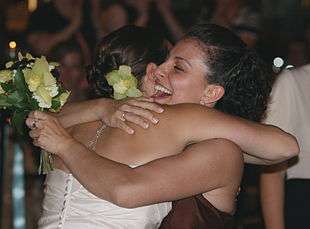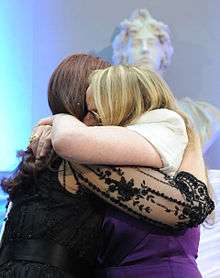Hug
A hug is a form of endearment, universal in human communities, in which two or more people put their arms around the neck, back, or waist of one another and hold each other closely. If more than two people are involved, it may be referred to as a group hug.

Etymology
The origins of the word are unknown, but two theories exist. The first is that the verb "hug" (first used in the 1560s) could be related to the Old Norse word hugga, which meant to comfort. The second theory is that the word is related to the German word hegen, which means to foster or cherish, and originally meant to enclose with a hedge.[1]
Characteristics
.jpg)

A hug, sometimes in association with a kiss, is a form of nonverbal communication. Depending on culture, context and relationship, a hug can indicate familiarity, love, affection, friendship, brotherhood or sympathy.[2] A hug can indicate support, comfort, and consolation, particularly where words are insufficient. A hug usually demonstrates affection and emotional warmth, sometimes arising from joy or happiness when reunited with someone or seeing someone absent after a long time. A non-reciprocal hug may demonstrate a relational problem. A hug can range from a brief one-second squeeze, with the arms not fully around the friend, to an extended holding. The length of a hug in any situation is socially and culturally determined. In the case of lovers, and occasionally others, the hips may also be pressed together. The emotionality of the hug furthermore influences the direction of the hug. In deeply emotional contexts, hugs tend to be more left-sided compared to hugs in neutral situations such as greetings. While the overall direction of hugs corresponds with physical motor phenotypes such as handedness, the emotional state induces an overall shift to the left attributed to right-hemispheric emotional processing. [3][4]
Unlike some other types of physical contact, a hug can be practiced publicly and privately without stigma in many countries, religions and cultures, within families, and also across age and gender lines,[5] but is generally an indication that people are familiar with each other. Moving from a handshake (or touch-free) relationship to a hug relationship is a sign of a closer friendship.
An unexpected hug can be regarded as an invasion of a person's personal space, but if it is reciprocated it is an indication that it is welcome. Some Western culture commentators advise avoiding hugs at work to prevent uncomfortable moments, especially with people who dislike hugging.[6] Also, a person, especially a child, may caress and hug a doll or stuffed animal. Young children also hug their parents when they feel threatened by an unfamiliar person, although this may be regarded as clinging onto rather than hugging because it demonstrates a need for protection rather than affection.
Cultural aspects


While less common, hugging may be undertaken as part of a ritual or social act in certain social groups. It is a custom in some cultures such as France, Spain and Latin America for male friends to hug (as well as slap each other on the back) in a joyous greeting.[7] A similar hug, usually accompanied by a kiss on the cheek, is also becoming a custom among Western women at meeting or parting. In Portugal and Brazil, it is common, mostly among males, to finish letters and emails with Um abraço or Abraço ("a hug", or "hug") followed by the sender's signature. Similar formulas may be used in oral communication. In the Roman Catholic rite of the Holy Mass a hug may be substituted for a kiss or handshake during the kiss of peace ritual.
In May 2009, The New York Times reported that "the hug has become the favorite social greeting when teenagers meet or part these days" in the United States.[8] A number of schools in the United States have issued bans on hugs, which in some cases have resulted in student-led protests against these bans.[9][10]
A Canadian journalistic investigation in 2015 noted the popularity of the hug in bromance among young francophone adults in Quebec.[11]
Some cultures do not use hugging as a sign of affection or love, such as the Himba in Namibia. During the Islamic fasting month of Ramadan, it is halal (permissible) for someone to hug one's significant other during daylight hours if one has self-control. However, if accompanied by libidinous urges, it is haram (sinful).[12]
In the south Indian state of Kerala a sixteen-year-old boy was expelled from school for hugging a girl after she won a prize at an arts competition. When the Kerala State Commission for Protection of Child Rights ordered the school to re-enroll the boy, it was challenged in the High Court. The Court nullified the Commission's order and upheld the school principal's order to expel the student, saying "The school principal is the institution’s guardian, vested with powers to take action necessary to maintain discipline and morality in the school. The child rights commission cannot interfere there."[13]
Health benefits
Hugging has been proven to have health benefits. One study has shown that hugs increase levels of oxytocin and reduce blood pressure.[14][15]
Based on significant research indicating that a 20-second-or-longer hug releases oxytocin.[16] Leo Buscaglia encourages people to hug for 21 days consecutively and to have each day a hug that lasts for a minimum of 21 seconds. He recommends "getting lost in the hug," encouraging people to slow down and "use the power of the hug to be fully present in the moment".
In the United States, 30,000 people have Williams syndrome and are prone to hugging others.[17]
Group hug

A group hug has been found to be a useful tool in group therapy to cement a sense of cohesion among the participants after a session,[18] although it may cause discomfort for group members who shy away from physical contact.[18]
Cuddling
.jpg)

Cuddling is a related form of physical intimacy in which two people hold one another with each other's arms wrapped around the other's body for an extended period of time. Cuddling can be with family members, friends or lovers. Similar to hugging, cuddling is a more affectionate and intimate embrace, normally done for a longer period of time (usually lasting from a few minutes to several hours). In contrast to hugging, which can often be a nonverbal greeting or parting tradition, cuddling is usually shared between two people who are lying down together or sitting somewhere in an intimate manner. Like hugging, cuddling makes the body release oxytocin, which has a variety of effects.
See also
References
- "hug - Origin and meaning of hug by Online Etymology Dictionary". etymonline.com.
- Kathleen Keating (1994). The Hug Therapy Book. Hazelden PES. ISBN 978-1-56838-094-0.
- Packheiser, Julian; Rook, Noemi; Dursun, Zeynep; Mesenhöller, Janne; Wenglorz, Alrescha; Güntürkün, Onur; Ocklenburg, Sebastian (2018). "Embracing your emotions: Affective state impacts lateralisation of human embraces". Psychological Research. doi:10.1007/s00426-018-0985-8. PMID 29349505.
- Ocklenburg, Sebastian; Packheiser, Julian; Schmitz, Judith; Rook, Noemi; Güntürkün, Onur; Peterburs, Jutta; Grimshaw, Gina M. (2018). "Hugs and kisses – the role of motor preferences and emotional lateralization for hemispheric asymmetries in human social touch". Neuroscience & Biobehavioral Reviews. 95: 353–360. doi:10.1016/j.neubiorev.2018.10.007. PMID 30339836.
- Duranti, Alessandro (1997). "Universal and Culture-Specific Properties of Greetings". Journal of Linguistic Anthropology. 7: 63–97. doi:10.1525/jlin.1997.7.1.63.
- "A New Rule For The Workplace: 'Hug Sparingly'". NPR. 2014-01-11.
- William Cane, The Art of Hugging: The World-Famous Kissing Coach Offers Inspiration and Advice on Why, Where, and How to Hug, St. Martin's Griffin, US, 2013
- Kershaw, Sarah (2009-05-27). "For Teenagers, Hello Means 'How About a Hug?'". The New York Times. Archived from the original on July 14, 2011. Retrieved 2009-05-29.
- Grant, Denise (2010-04-15). "Students pan hugging ban". Archived from the original on 2012-03-20.
- "School Bans Hugs Over 2 Seconds". 2008-03-02. Archived from the original on May 16, 2008.
- Lili Boisvert, radio-canada.ca, Bromance : ces gars qui craquent pour leurs amis Archived 2016-09-11 at the Wayback Machine, Canada, January 19, 2015
- Archived October 20, 2014, at the Wayback Machine
- "Kerala Class 12 Student Expelled For Hugging In School, HC Upholds Order".
- "How hugs can aid women's hearts". BBC News. August 8, 2005. Retrieved 2008-11-28.
- Light, Kathleen C.; Grewen, Karen M.; Amico, Janet A. (2005). "More frequent partner hugs and higher oxytocin levels are linked to lower blood pressure and heart rate in premenopausal women". Biological Psychology. 69 (1): 5–21. doi:10.1016/j.biopsycho.2004.11.002. PMID 15740822.
- "The health benefits of hugging".
- "This Rare Medical Condition Makes You Love Everyone". 16 July 2017.
- Albert Pesso, Movement in Psychotherapy: Psychomotor Techniques and Training (1969), pp. 92–93.
External links
